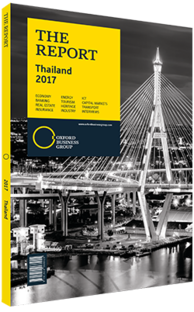Expansion at Thailand's Laem Chabang port aims to make it a regional hub
First identified as a favourable alternative to the crowded Bangkok seaport as early as the 1960s, Laem Chabang Port has expanded from being Thailand’s first deepwater port served by a single terminal into one of the busiest ports in the region. Since the initial B1 and B2 terminals began operations in the early 1990s, Laem Chabang has grown alongside the country’s mounting industrial prowess, and continues to serve as the primary terminal for the import of industrial inputs and other consumables into the country, as well as the export of Thai manufactured goods.
As of 2015 the facility was ranked the 22nd-busiest port in the world for container traffic, according to data compiled by the World Shipping Council. The 6.82m twenty-foot equivalent units (TEUs) that moved through Laem Chabang in 2015 were the most ever accommodated at the port, with volumes increasing every year since 5.73m TEUs passed through in 2011. Although this volume ranks below global heavyweights in China and regional standouts such as Rotterdam, Antwerp, Jebel Ali and Los Angeles, it did place the Thai port ahead of other local competitors, such as the ports at Ho Chi Minh in Vietnam, Tanjung Priok in Indonesia and Manila in the Philippines.
Following the completion of its first and second phases of development, Laem Chabang currently boasts infrastructure with the ability to accommodate the largest classification of container vessels, known as super-post-Panamax. The port’s 13 terminals are capable of handling a variety of cargo, including the roll-on/roll-off (ro-ro) capabilities necessary to service the country’s expansive automobile industry, while it also has seven container terminals. In addition, the port also contains one multipurpose terminal, a combined ro-ro and passenger terminal, a general cargo terminal and a shipyard terminal. Total annual capacity for the site is currently rated at 11m TEUs and 1.5m vehicles.
Upping The Ante
While Laem Chabang has so far proven capable of accommodating Thailand’s expanding export-oriented agricultural and manufacturing industries, along with the increased flow of goods into the country, the expected growth of these sectors should soon push shipping traffic beyond the port’s current capabilities. With this in mind, and the fact that Bangkok Port is restricted to its current capacity due to its proximity to built-up areas, the government is proceeding with a third stage of development at the site.
Upgrades
Billed as a plan to develop the port into a regional hub to complement leading shipping destinations such as Singapore, the government has included a BT1.8bn ($50.7m) upgrade plan for the facility as a priority project in the Transport Infrastructure Development Master Plan 2015-22. In addition, another BT2.03bn ($57.2m) has been allocated for the construction of a single-rail transfer project at the port. “Laem Chabang Phase 3 will be an important project as it will [be developed] to become ‘the Rotterdam of ASEAN’ to help distribute goods from China, Laos, Cambodia and Myanmar [to the rest of the world],” Kobsak Pootrakool, vice-minister at the Prime Minister’s Office, told local media in July 2016.
This third stage of upgrades will add a new U-shaped jetty – measuring 800 metres wide and 2 km long – to the port. The new structure will house nine new quays capable of accommodating super-post-Panamax vessels with up to 100,000 deadweight tonnes, as well as container vessels with a capacity in excess of 10,000 TEUs. Upon completion, the new additions, which also include seven new container terminals, a new mixed general cargo terminal and a new ro-ro terminal, will increase the port’s annual container capacity to 18.8m TEUs per year, 2.57m tonnes of general cargo and 1.95m vehicles. The expansion will support the country’s push to accelerate growth in the crucial Eastern Economic Corridor, further boosting many existing manufacturing industries such as the automotive and electronics, as well as the planned home for future industries included in the Thailand 4.0 industrial modernisation strategy.
You have reached the limit of premium articles you can view for free.
Choose from the options below to purchase print or digital editions of our Reports. You can also purchase a website subscription giving you unlimited access to all of our Reports online for 12 months.
If you have already purchased this Report or have a website subscription, please login to continue.

